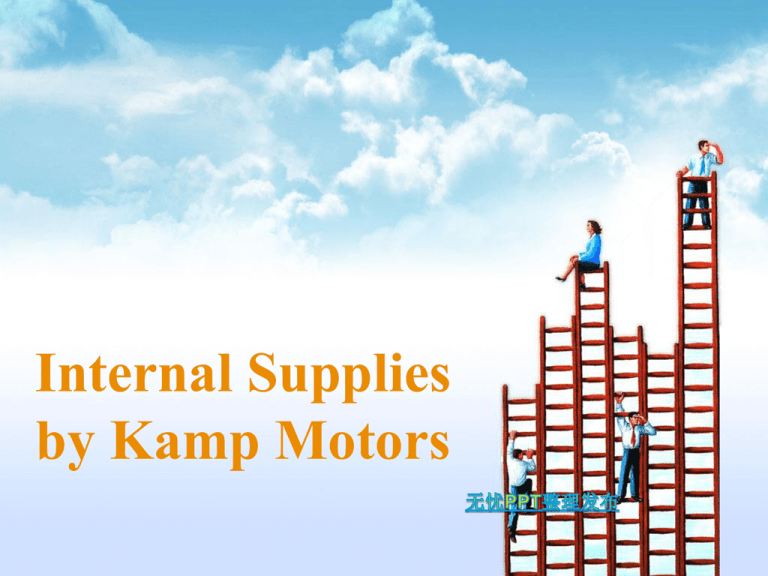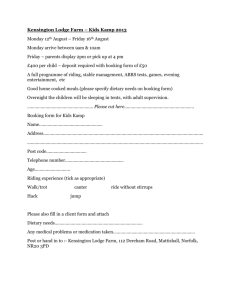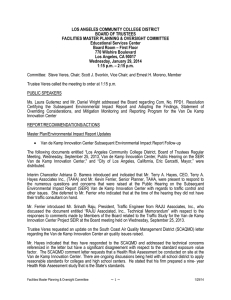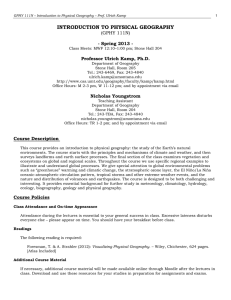Internal Supplies by Kamp Motors
advertisement

Internal Supplies by Kamp Motors Vécu and Kamp Vecu is a French company produces cars and lorries, buses and agricultural machinery. Vécu is made up of a independent divisions which have been subdivided into business units The MA division produces exclusive models only The MB, MC divisions are also supplied with quite a lot of engines by Kamp Kamp Motors of Roosendonk, the Netherlands is one of Vécu’s subsidiaries has more than 2,300 employees an international leader in the field of engine production has been closely involved in developing racing car engines for many years. several of the components for Kamp’s engines are supplied by other businesses Kamp produces four main types of car engines Type 1 - quite conventional , is supplied mainly to businesses outside the Vécu concern Types 2,3,4 - high-tech, are supplied only internally A considerable number of engines of Vecu is purchased externally Vecu has to decide whether to fit it with a Kamp engine or an engine purchased from an external supplier. The fact that other manufacturers generally cannot supply attractively priced engines which meet Vécu’s specifications. Financial Information On Kamp Relating to 2001 Some financial data on Kamp Motors, 2001; x €1 million Sales 361 External costs*) 204 Staff costs 98 Depreciations 20 Number of employees 2330 *) External costs: costs of raw materials and auxiliary materials, purchased components, contracted work, etc. Incentives At the end of 2000, the board of the Vécu concern decided to give the divisions and business units stronger incentives Incomes of managers dependent on the profits made by their units At the beginning of 2002, the board of Kamp noticed that the management of some segments of Vécu were entitled to considerable bonuses over 2001. The board was very sorry to conclude that the management of Kamp were not in the same position. The board would not take this lying down started to look for possibilities of increasing the profit of their own business unit. Type 1 yields a nice profit Engines types 2, 3, 4 internally at costs per unit plus a small mark-up for profit (was ordained by the boards of the MA division and Vécu several years ago) but reduction cost of these types can not increase profit bcpu = external cost per unit + (staff and depreciation costs) : standard capacity In 2002, Vercu want to make a contract with Kamp for supplying 5000 engines annually. Kamp would have to alter the type 2 engine by 2a for the MB99. Vercu also has 2 other potential suppliers are British company Black and the Italian company FER. Vercu just want to get engines from Kamp, but only with exceptional, technically speaking, and reasonably priced. Although Vercu want Kamp to reduce supplying price, Kamp is considering the contract because Kamp want to increase the degree of capacity utilization for its current production somewhat. Actually, Kamp cannot supply engines at lower prices until Kamp has cut costs and that will take time. Kamp must ask if it should not supply more engines externally and if it should not stop supplying engines internally at cost per unit plus a small mark-up for profit. But those questions will be dealt with in the long term. Kamp’s engine meets Vercu’s technical requirements more than adequately. The first 5,000 engines could probably be produced relatively easily with its available production machinery. Since the demand for cars and engines is expected to rise steeply in the coming years, capacity may become a problem, especially if Kamp is allowed to supply engines of the types 2, 3, and 4 to external customers. If Kamp is allowed to sell externally, it will probably supply external customers with engines yielding a profit of at least €750 per unit Full cost per unit for the type 2a will amount to €4,000, includes a part of the development costs €200 per unit and the variabele costs €2,500/unit. Kamp does not yet know the exact prices of the engines from Black and FER,but it suspects that they range between €3,750 and €4,250. Technically speaking, the Black and FER engines are probably not as good as the Kamp engines, but they probably meet Mercier’s requirements. Vecu wants to put forward a proposal for the price at which Kamp is willing to supply the type 2 engine and to get a transfer price which will satisfy Kamp in the near as well as the more distant future. Question 1: Transfer price Kamp should insist on if it were to supply the type 2a engine to the MB division now and in the future minimum transfer price = variable cost per unit + opportunity costs = 2500 + 750 = 3250 Question 2 Discuss the possibilities of increasing Kamp’s profit by using the formula for basic cost per unit and by reorganizing? The board of Kamp consider reducing costs by reorganizing its organization and not reducing the units costs of the types 2, 3, and 4. Considering of reorganization of Kamp’s cost information system. The company should review the total cost for producing, decrease, save and ignore costs that not in need. That might result in more profit for Kamp. Changing the department of Research and Product Development. The company will redesign this department by remaining the leader in the field of technology instead of employing all the staff for this department as it used to do to decrease the development cost. This will decrease the fixed cost the total cost will be decreased Contemplating much closer collaboration with technical universities With collaboration with technical universities, this will take more advantages from technology to save produce cost any way increase profits. Besides through cost reductions, profits can also rise if sales proceeds increase. That is why the board of Kamp is wondering whether the company might benefit from supplying the types 2, 3, and 4 externally as well. Question 3 Within the Vécu concern, Kamp is obliged to supply engines at cost per unit plus a mark-up for profit. Please compare Vécu's transfer price system with Eccles's theory on transfer pricing. Vecu’s tranfer price system Standard capacity has been set at 90% of its maximum production capacity Kamp transfer price system base on the principle: Minimum transfer price = variable cost/ unit + opportunity costs for the suppliers Eccles's theory on transfer pricing Transfer price is market price The market price is the opportunity cost when a selling division is at full capacity. Sales at less than market result in lost business that would have been a market prices. The basic advantage of using market prices is that they allow each division to be evaluated on a standalone basis. Measures of income have more validity when market prices are used. Question 4 Taking into consideration the product differentiation strategy adopted by Kamp and Vécu, what do you think of Kamp's idea to collaborate more closely with technical universities and to sell the types 2, 3, and 4 externally as well? Answer Because Kamp’s engines meet Vercu’s technical requirement more than adequately. While the supply price doesn’t make Kamp get much profit. Moreover, the demand for cars and engines is expected to rise steeply in the coming year. So the idea that collaborating more closely with technical universities and selling the types 2, 3 and 4 externally as well are good ways for Kamp to decrease the producing cost and get more profit for the company and especially save the opportunity cost of selling engines externally. Kamp should promote these ideas because of their positive effect Thanks For Your Listening





